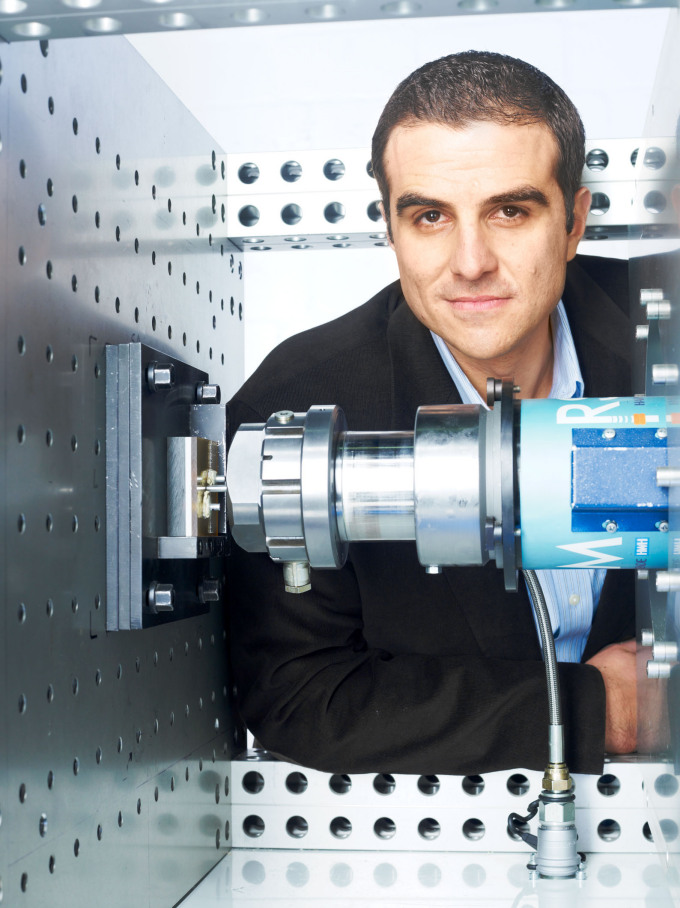Close to the limits? GKSS researchers examine new high-performance materials
In January 2010, a new Helmholtz university junior research group was set up at the GKSS Research Centre in Geesthacht. The leader of the junior research group is GKSS employee, Dr. Sergio Amancio. Partner university is the Technical University of Hamburg-Harburg (TUHH). The new group devotes itself to the interface properties of polymer-metal hybrid structures produced by advanced joining technologies. About two million euros are available to the multiple-award-winning young researcher.

Photo: HZG/ Christian Schmid
Helmholtz university junior research groups provide young, talented researchers with optimal conditions: junior research team leaders can carry out research independently and implement their own ideas. "Here in Geesthacht, I benefit from the facilities and the optimal working conditions," declared Dr. Sergio Amancio. "At the same time, I can pursue a university career through the planned seminars and lectures I am going to give at the TU Hamburg-Harburg.”
A junior professorship at the TUHH is planned for the junior research group leader Amancio. With this in mind, Prof. Dr. Jürgen Mlynek, President of the Helmholtz Society, says: "Through the joint appointment of junior research team leaders to junior professorships, the collaboration with the Helmholtz Society is to be anchored more strongly in institutional terms."
Sergio Amancio's research focus lies in the joining technology field – a sector that is important for instance in aircraft construction, for joints or welding seams are the weak spots in aircraft structures. This is usually where cracks are formed. Intensive research is therefore necessary before new material combinations can be used in aircraft construction.
Creating a secure connection
Amancio's new junior research group "Advanced Polymer-Metal Hybrid Structures”, at the Institute of Materials Research in Geesthacht, examines the interface properties of these new high-performance materials. Such hybrid structures between plastic composite materials and lightweight alloys have hardly been tested as yet at the laboratory scale. Some of the novel plastics, so-called polymer-based nanocomposites, being developed at the Geesthacht Institute for Polymer Research will be analysed in collaboration with the junior research group.
About two million Euros for the jurnior researcher
Dr. Sergio Amancio has prevailed before an interdisciplinary jury in a multi-level competition process involving expert peer reviews and presentations: since 2002, the Helmholtz Society has sponsored a total of 116 junior research groups. Half of the expenses are covered by the Helmholtz Society's Incentive and Networking fund. The junior research groups receive the other half of their financing from the Helmholtz centres. With funding of 1.9 million Euros, junior research group leader Amancio is able to finance five additional employees as well as laboratory equipment for five years.
Additional information:
Glossary
Dr.-Ing. Sergio T. Amancio Filho:
Amancio studied Material Engineering at the University of Sao Carlos, Brazil (graduated in 2000). He holds a Master of Science in Metallurgy through a combined study at the University of Sao Carlos and the GKSS Research Centre in 2002. In 2007, he received a doctorate in Engineering at TU Hamburg-Harburg in the field of Joining Technology.
Since 2001, Dr. Amancio has been carrying out research in the Department of Solid-State Joining Processes at the GKSS Research Centre in Geesthacht. He is the owner of two patents and nine patent applications for joining techniques.
In 2007, he received the Nordmetall award for his PhD thesis; in 2009, the Henry-Granjon award by the “International Institute of Welding”
Composite materials:
Everyone knows these materials from everyday life: particle boards such as chipboard or Plywood are composite made of wood and plastic (adhesive). Mixed Cement, sand gravel, steel and water also form a composite, the concrete. fibre-reinforced ceramics can be found in brake discs. The use of the composite materials/lightweight construction hybrid structures being developed and analysed in Geesthacht could reduce the weight of vehicles. Less weight means lower energy consumption and lower emissions, thereby going easy on resources and on the environment.
Lightweight Hybrid Structures:
These are hybrid structures with manifold layer systems consisting of the most diverse materials such as plastics (polymers), aluminium, magnesium and titanium alloys. It is no longer possible to imagine modern lightweight construction without polymer-metal hybrid structures, due to their excellent structural characteristics. However, their manufacturing methods and joinability are very complex due to the different nature of polymers and metals. Metals and polymers do not like to mix and can therefore be combined with each other only by means of highly developed techniques.
Nanocomposites/nanocomposite materials:
Nanocomposites/nanocomposite materials can feature better strength characteristics than usual polymer composite materials, for instance in vehicle construction. Their properties and structure, however, have barely been researched yet. These innovative new plastics are being currently manufactured and investigated at the Geesthacht Institute for Polymer Research.
